Planet Earth/1f. The Nature of Time: Solar, Lunar and Stellar Calendars
What is Time?
[edit | edit source]Time is measured by the motion of the Earth in respect to other astrological objects. A day is measured as the time it takes Earth to fully rotate around its polar axis. A lunar month is measured as the time the moon takes to fully rotate around the Earth, while a year is measured as the time Earth rotates around the Sun. The measurement of time is of vital importance to measure, as time determines when to plant and harvest crops, signal migrations for hunting, forecast the weather and seasons, catch an airplane at the airport, attend class, and take your final exam. Time has become ever more divided into hours, minutes and seconds, and hence every moment of your life can be accounted for in this celestial motion of our planet.
Length of the Earth’s Year
[edit | edit source]For centuries, time has been a direct measure of Earth’s velocity or speed, and its motion relative to other astrological objects. The oldest Solar and Lunar calendars designed to track the passage of the Sun and Moon in the sky dates back 7,000 years ago, well before the Bronze Age, when humans were still using stone tools, but were utilizing agriculture and had domesticated animals. It became important to keep track of the passage of time to signal the time to start the planting of seeds and harvesting of crops. And for nomadic groups it also signaled the time to move a camp, as winter and foul weather could entrap nomadic groups during an unexpected winter storm, as well as signal times of the year to meet in large groups with various other tribes.
Solar Calendars
[edit | edit source]One of the key issues for people to solve was how many days were in a year, remarkably each culture and civilization around the world came to a close agreement that there are 365 days in a year, with some recognizing an extra quarter day. To make this calculation each group of people had to determine the motion of the sun either from the horizon, or at the highest point the sun reached at noon in the sky.
Ancient stone monuments and solar calendars are found around the world, which measure the motion of the sun for each day. The length of days between the Summer Solstice when the Sun is highest in the sky at noon, marked the turning point, as did the Winter Solstice when the Sun is lowest in the sky at noon. People living in equatorial regions, in which the seasons are not as pronounced, were less concerned with the passage of the Sun, and the measurement of the solar year, rather they often kept track of the passage of the Moon and its phases in the night sky. Solar record keeping of time is found across the cultures of Europe, Asia as well as Pre-Columbian America, while lunar record keeping of time is more standard in the Middle East and Africa, in regions closer to Earth’s equator.

Ancient monuments erected to measure the passage of time include Stonehenge in England which appears to line up with the Summer Solstice, the ancient tombs or stone dwellings of Maeshowe in Scotland, and Newgrange in Ireland, built nearly 5,000 years ago, in which sun light projects into the darken stone shelter on key days of the year. Some of the most sophisticated early solar calendars are found in the Americas, including El Castillo, or the Kukulcán's Pyramid in Yucatan Mexico. Constructed about 1,200 years ago, the pyramid contains 365 steps in total, divided by four cardinal directions of 91 steps each. The four-sided pyramid faces a direction that during the spring and autumn equinoxes the sun casts a shadow that resembles a feathered serpent, which is also depicted in sculptures found around the pyramid. Near the ancient Pueblo City of Chaco Canyon in New Mexico, there is an isolated butte where a 1,000-year-old solar calendar in the form of a swirling petroglyph can be found. A dagger of sunlight falls within its center on the Summer Solstice which moves to the edge of the swirling petroglyph on the Winter Solstice. In fact, the entire city of Chaco Canyon, and surrounding structures appears to be aligned to solar directions, as suggested by Anna Sofaer, and followed by Pueblo peoples today.
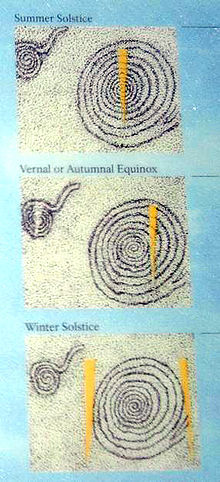
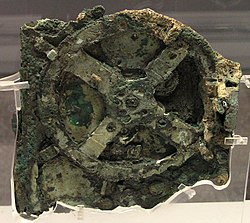
Combining Solar and Lunar Calendars
[edit | edit source]Solar and Lunar calendars became key to the synchronization of times in which people would gather, for religious events, festivals or sporting competitions, such as the 4-year cycle of the Olympic games in Greece or annual Powwow ceremonies in North America. However, each calendar differed, as a mix of days divided either in lunar months or laid over a solar year, or some mix of the two. The oldest calendar known that synchronizes the solar and lunar days is a 19 solar year cycle divided into 235 lunar months developed by Meton of Athens, an early Greek astronomer. After 235 lunar months, the moon and sun would restart their cycle in the sky, and the cycle would repeat, starting on the Summer Solstice. This early calendar was modified 200 years later by another Greek astronomer, named Callippus, who recognized an additional 76 year-long cycle determined by the variations in the length of the four seasons, which ranged from 94 to 89 days. This new calendar was set at the summer solstice in the year 330 BCE, and to keep track of this calendar geared mechanisms was invented to count the days and position of the moon, sun and stars. An example is found in the Antikythera mechanism, a maritime calendar dating to about 100 BCE.
Months of the Year
[edit | edit source]Our modern calendar, consisting of a solar year divided into 12 pseudo-lunar months was first implemented in Rome, around 700 BCE, which added the months of Ianuarius and Februarius to the already named 10 months used prior, which were number (1) Martius, (2) Aprilis, (3) Maius, (4) Iunius, (5) Quintilis, (6) Sextilis, (7) September, (8) October, (9) November, (10) December. Unlike the Greek calendar which combined solar and lunar cycles, the Roman calendar utilized just the solar cycle, which meant that the months had a set length of days. However, this presented a problem, since the solar year can’t be divided into an even 365 days. Every four years there would need to be an extra day to add to the calendar. Early Roman calendars would add an extra month (called Mercedonius), and kept the number of the days alternating between 355 days (a 12-month lunar year) and 377 days, with an average of 366.25 days. This meant that the summer solstice would vary by just a day on this calendar. However, this calendar was complicated because some years had an extra month, and if a city or region forgot or disregarded this extra month, the calendar would be off. After over 700 years of use, Julius Caesar issued a reform to the Roman calendar, by eliminating the extra month, and adding an extra day every four years, Leap Years. This calendar was called the Julian Calendar after Julius Caesar, who was killed on the Ides of March (March 15th) in 44 BCE. His adopted son Octavian rose to power in Rome, and in 27 BCE took the name Augustus, which became the new name of the month of Sextilis, since his rule occurred after Julius Caesar, so he named the month preceding August, which was Quintilis to July, in honor of Julius Caesar. The months were now named January, February, March, April, May, June, July, August, September, October, November, and December, with a leap day added to the month of February. This calendar was adopted across the entire Roman empire, and used for over a fifteen hundred years, and still used in some regions of the world today.
However, in 1582 CE the dates of the spring equinox were off by 10 days, because under the Julian Calendar each year was 0.0075 days shorter than the Earth’s rotation around the sun, which is not much, but represents 11.865 days after using the system for 1,582 years. To correct this the astronomer Aloysius Lilius advocated for a jump forward of 10 days, which was proposed by Christopher Clavius to Pope Gregory XIII, who decreed that October 4th 1582 would advance to October 15th 1582. To help prevent future wandering, leap years were modified as occurring every four years, except years that are evenly divisible by 100, but are leap years if they are evenly divisible by 400. The idea was unpopular and not fully adopted everywhere, particularly by Protestant and Eastern Orthodox countries, but over the centuries the Gregorian Calendar, which is the best fit to the Earth’s rotation around the Sun has become the standard solar calendar.
Lunar Calendars
[edit | edit source]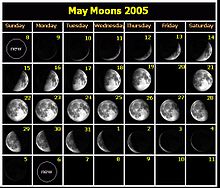
However, even today calendars utilizing the moon’s rotation are still used. The lunar Hijri calendar observed in the Middle East and North Africa (and by religious followers of the Muslim faith) follows 12 lunar months divided into 355 days a year. This lunar calendar determines the months of Ramadan and Dhū al-Ḥijjah, which are important holy lunar months in the Islamic calendar. Because this lunar calendar follows the moon, the months of Ramadan and Dhū al-Ḥijjah do not line up with the solar calendar, so the start of the month of Ramadan shifts in relation to the Gregorian Calendar. In 2020 CE Ramadan started on April 24th and in the year 2030 CE on December 26th. The Islamic calendar numbers the 12-month lunar years from the first year of Muhammad’s journey to Medina, abbreviated AH (for Anno Hegirae).
The Method of Counting Years
[edit | edit source]Using a solar calendar in Rome, the years were counted since the founding of the city of Rome or AUC (for Ab urbe condita) in 754 BCE. Early Christians numbered the annual years by Anno Diocletiani, or years since the rule of the Roman Emperor Diocletian, who persecuted early Christians in Nicomedia near present day Istanbul and destroyed earlier records. These years were later modified by a monk named Dionysius Exiguus, who adjusted the year from 247 Anno Diocletiani to 532 Anno Domini by calculating the birth year of Jesus Christ to the reign of the Roman Emperor Augustus during his 28th year in power. Hence AD for (Anno Domini, which means the year of our Lord) became standardized across Christian nations of Europe by around 700 CE. With the wide spread use of the solar Gregorian Calendar, the AD system of numbering solar years remained in place, but referenced in non-religious scientific use by denoting the Common Era (CE) and Before Common Era (BCE). This system is used throughout this text. Note that using this system 1 BCE is preceded by 1 CE, with BCE decreasing over time, and CE increasing over time, with the birth of Jesus Christ as the 1st year in this system.
Stellar Calendars
[edit | edit source]
Using the sun or moon are not the only ways in which to keep track of time, since the Earth rotates around its polar axis each year, stars will appear on the horizon at different times of the night, and appear in different locations depending on the time of year (just like the sun and moon). A stellar calendar was first used in Egypt and recorded in a series of texts collectively called the Book of Nut, which is also depicted in the Tomb of Ramses IV, who reigned in Egypt around 1150 BCE. The Book of Nut recognizes 36 stars or combination of stars in the night sky, which arise in the night sky in different places every 10 days. The ten-day periods are called decans, and represent 360 nights in a year which is close to the actual 365.242 nights in a modern calendar year.
Length of the Earth’s Day
[edit | edit source]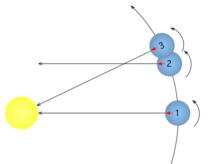
Using stars to measure time is referred to as sidereal time. Sidereal time differs from solar time (which uses the position of the sun), the reason for this is that Earth makes one rotation around its axis in a sidereal day and during that time it moves a short distance (about 1°) along its orbit around the Sun. So after a sidereal day has passed, Earth still needs to rotate slightly more before the Sun reaches local noon according to solar time. A mean solar day is, therefore, nearly 4 minutes longer than a sidereal day. Hence the rotation of the Earth is 23 hours 56 minutes and 4.1 seconds, while the Solar day is 24 hours. Another way to think of this is that a star (other than the sun) represents a distant point of reference, while the closer Sun point of reference has moved slightly in relation to the orbiting Earth. The difference between the Sidereal Year, when a star returns to the exact same position in the night sky, and the Solar Year (also called a Tropical Year) when the sun returns to the exact same position in the daytime sky is only about 21 minutes shorter. Astronomers use Sidereal time to track stars in the night sky, while clocks tend to read Solar time.
Hours in an Earth Day
[edit | edit source]
In the Book of Nut, the day is divided into 24 hours, representing 12 hours of the night, and 12 hours of the day. These were measured by the times stars appeared in the night sky, and Sun dials, which measured the 12 hours of the day. However, keeping track of the hours of the day were not necessarily standard units of time. For example, in China hours were recorded as the Shí-kè (時 - 刻) during day light hours by tracking the sun, and Gēng-diǎn (更 - 點) during the night with the sound of gongs. In medieval Europe hours were announced from bell towers, which divided the day into 8 non-standard hours called Matins, Prime, Terce, Sext, None, Vespers, Sunset and Compline, and while tracking the Sun and Stars positions could be used to determine these hours, they were not standardized.
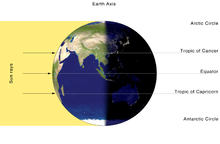
With the advent of mechanical clocks during the Renaissance, keeping track of the hours of the day became more uniform, with the introduction of 60 minutes to a standard hour in a 24-hour day, which was first measured by a clockmaker named Jost Bürgi in 1579 CE for use in astrological tracking of the stars and planets at night in the court of Emperor Rudolph II working alongside Johannes Kepler. But the terms for minutes and seconds in reference to time originate with the work of Johannes de Sacrobosco, who was the first to calculate the shift in the occurrence of the Spring Equinox according to the Julian Calendar in 1235 CE. As smaller standard units of measurement of time, minutes and seconds were vital to understanding very long-term oscillations in the orbit of the Earth and help calculate the occurrence of the Spring Equinox.
| Previous | Current | Next | |
|---|---|---|---|
|
g. Coriolis Effect: How Earth’s Spin Affects Motion Across its Surface. |
